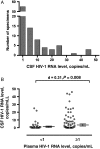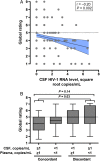Prevalence and Correlates of Persistent HIV-1 RNA in Cerebrospinal Fluid During Antiretroviral Therapy
- PMID: 27789723
- PMCID: PMC5225254
- DOI: 10.1093/infdis/jiw505
Prevalence and Correlates of Persistent HIV-1 RNA in Cerebrospinal Fluid During Antiretroviral Therapy
Abstract
Background: Neurocognitive disorders remain common among human immunodeficiency virus (HIV)-positive adults, perhaps owing to persistent HIV-1 RNA in cerebrospinal fluid (CSF) during antiretroviral therapy (ART).
Methods: Using a single-copy assay, we measured HIV-1 RNA levels in CSF and plasma specimens from 220 HIV-positive adults who were taking suppressive ART. Fifty-five participants were tested twice.
Results: HIV-1 RNA was detected in 42.3% of CSF and 65.2% of plasma samples. Correlates of higher CSF HIV-1 RNA levels included higher nadir and current CD4+ T-cell counts, a plasma HIV-1 RNA level of ≥ 1 copy/mL, and a lower central nervous system penetration-effectiveness score (model P < .001). Worse neurocognitive performance was associated with discordance in HIV-1 RNA detection between plasma and CSF, lower overall CSF HIV-1 RNA level, and longer ART duration, among others (model P < .001). In the longitudinal subgroup, CSF HIV-1 RNA persisted in most participants (69%) over 7 months.
Conclusions: Low-level HIV-1 RNA in CSF is common during suppressive ART and is associated with low-level HIV-1 RNA in blood, better immune status, and lower ART drug distribution into CSF. The association between HIV-1 RNA discordance and HIV-associated neurocognitive disorder (HAND) may reflect compartmentalization. The relationship between HAND, lower HIV-1 RNA levels in CSF, and lower CD4+ T-cell counts may reflect disturbances in the immune response to HIV-1 in the CNS.
Keywords: HIV; antiretroviral therapy; cerebrospinal fluid; cognitive disorders.
© The Author 2016. Published by Oxford University Press for the Infectious Diseases Society of America. All rights reserved. For permissions, e-mail journals.permissions@oup.com.
Figures



References
-
- Simioni S, Cavassini M, Annoni JM et al. . Cognitive dysfunction in HIV patients despite long-standing suppression of viremia. AIDS 2010; 24:1243–50. - PubMed
-
- Becker JT, Lopez OL, Dew MA, Aizenstein HJ. Prevalence of cognitive disorders differs as a function of age in HIV virus infection. AIDS 2004; 18(suppl 1):S11–8. - PubMed
-
- Valcour V, Shikuma C, Shiramizu B et al. . Age, apolipoprotein E4, and the risk of HIV dementia: the Hawaii Aging with HIV Cohort. J Neuroimmunol 2004; 157:197–202. - PubMed
MeSH terms
Substances
Grants and funding
LinkOut - more resources
Full Text Sources
Other Literature Sources
Medical
Research Materials

